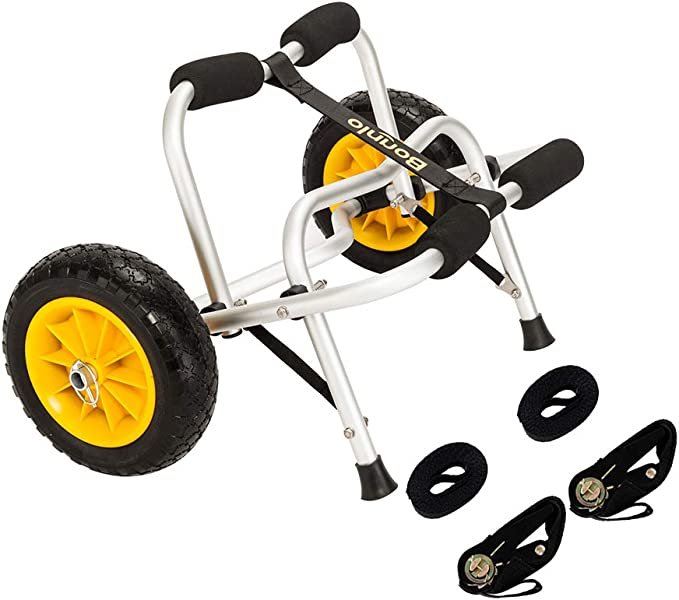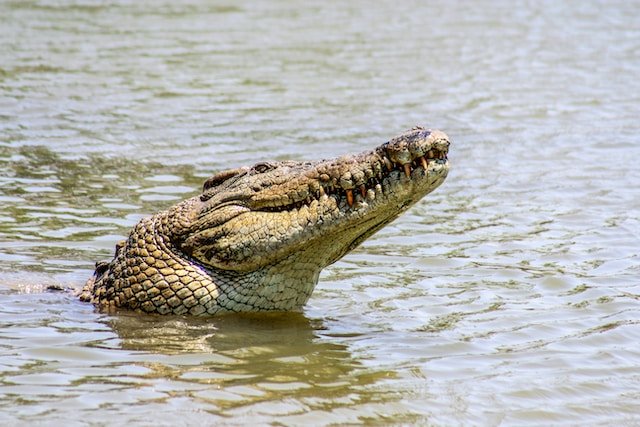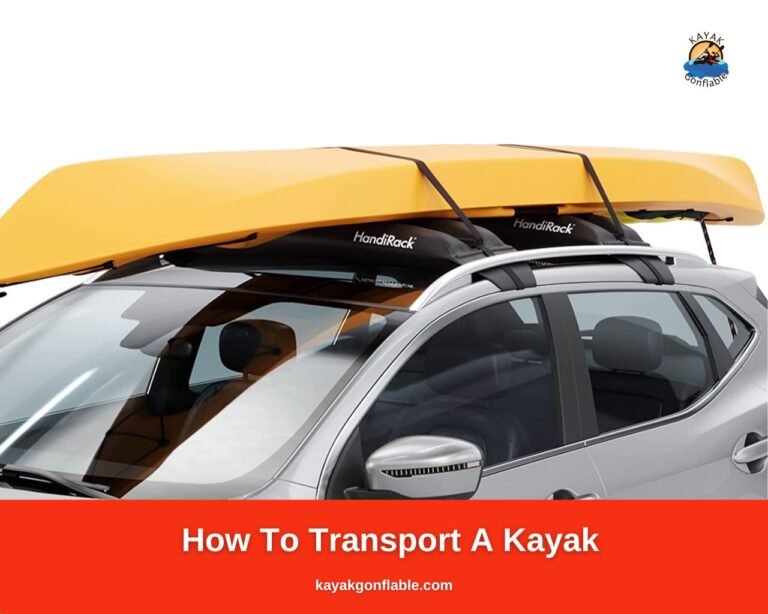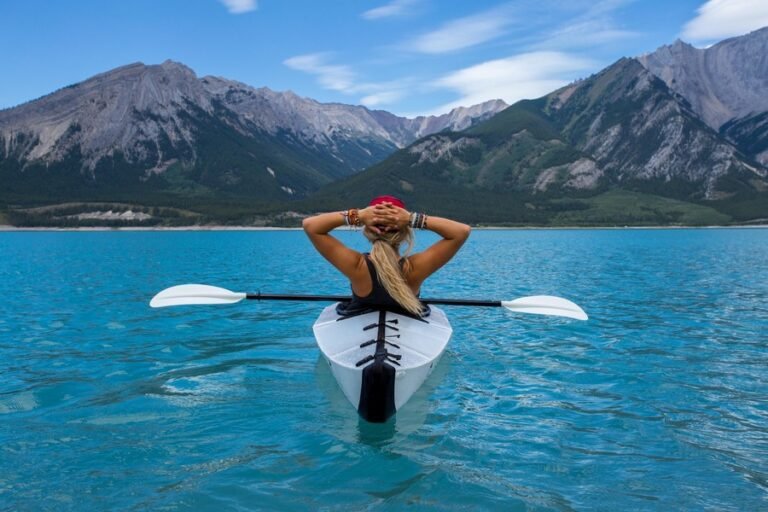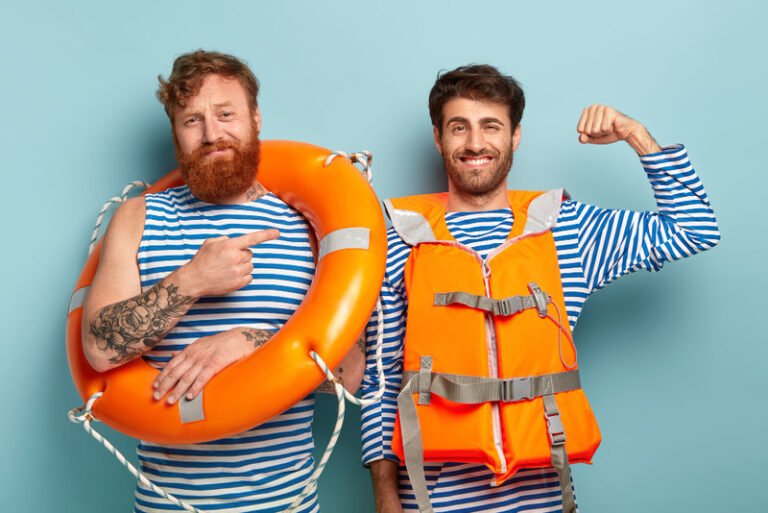What To Wear Kayaking In Alaska

Kayaking in Alaska offers a breathtaking adventure amidst pristine wilderness, glaciers, and wildlife. However, to fully enjoy this experience, one must be well-prepared, and that starts with choosing the right clothing. The frigid waters and unpredictable weather in Alaska demand careful consideration of your clothing.
Understanding Alaska’s Climate
Alaska’s climate is as diverse as its stunning landscapes, ranging from temperate coastal zones to arctic tundra. Before delving into what to wear while kayaking in Alaska, it’s essential to comprehend the intricacies of this state’s climate.
Diverse Climate Zones
Alaska’s geography spans over 663,000 square miles, hosting a variety of climate zones.
- Coastal Regions: The southern coastal areas, like those around Juneau and Ketchikan, experience milder temperatures and more precipitation. The area is close to the sea and has relatively mild winters and cooler summers.
- Interior: Moving inland, places like Fairbanks encounter a subarctic climate, characterized by extremely cold winters and warm summers. These regions showcase the full spectrum of temperature extremes.
- Arctic Tundra: Northern Alaska, including areas above the Arctic Circle, features an arctic climate with frigid winters, icy waters, and extreme temperature variations between seasons.
- Mountainous Areas: The mountainous terrain, such as the Alaska Range, can create microclimates where weather conditions can change rapidly.
Dressing for Variable Conditions
Given this climatic diversity, dressing appropriately for kayaking in Alaska becomes all the more critical. The state’s weather patterns are known for their variability, with changes occurring swiftly and often unexpectedly.
Sudden Temperature Shifts: Alaska’s temperature can vary dramatically within a single day, especially in the coastal regions. Dressing in layers allows you to adapt to these fluctuations, ensuring you remain comfortable.
Unpredictable Weather: Rain, wind, and fog are common companions on Alaskan waters. A proper kayaking outfit should shield you from these elements while providing breathability to prevent overheating.
Potential for Rapid Cooling: If you capsize or take an unexpected swim, the cold waters can quickly lead to hypothermia if you’re not adequately dressed. High-quality wetsuits or drysuits are essential for insulation in these circumstances.
Wind Chill: The wind can make even moderate temperatures feel much colder. Outer layers should be windproof to reduce the wind chill factor.
Sun Exposure: Surprisingly, Alaska can also experience intense sunlight during the summer months. Sunburn is a real concern, especially with the sun’s reflective glare off the water. Don’t forget to wear sunscreen, sunglasses, and a hat.
Layering Your Clothing for Comfort and Warmth
When kayaking in Alaska’s ever-changing climate, mastering the art of layering is essential to ensure comfort, warmth, and adaptability throughout your journey.
Layering involves wearing multiple clothing layers, each serving a distinct purpose. The benefits of layering in Alaska include;
Temperature Regulation: Layers allow you to adjust your clothing to the changing weather conditions, helping you stay comfortable in hot and cold spells.
Moisture Management: Proper layering helps wick moisture away from your skin, preventing sweat accumulation, which can lead to discomfort and even hypothermia in cold conditions.
Insulation: The layers trap warm air, providing an insulating barrier against the cold. This is particularly crucial when kayaking in Alaska’s chilly waters.
Versatility: With layers, you can easily add or remove clothing as needed, adapting to the unpredictable Alaskan climate.
Base Layer
Opt for base layers made of moisture-wicking materials like merino wool or synthetic fabrics. These materials draw sweat away from your skin, keeping you dry and preventing chilling.
Base layers come in different thicknesses, from lightweight to heavyweight. Choose the thickness based on the expected weather conditions. In colder weather, a thicker base layer offers more insulation.
Mid-Layer
Fleece is an excellent choice for a mid-layer. It provides warmth, even when wet, and is highly breathable. Fleece jackets and pullovers are versatile and can be easily added or removed as needed.
Down jackets are incredibly warm and lightweight. They provide excellent insulation but should be reserved for drier conditions, as down loses its insulating properties when wet.
Ensure your mid-layer fits comfortably over your base layer and allows for a full range of motion. Mobility is crucial when kayaking, so choose a mid-layer that doesn’t restrict your movement.
Outer Layer
Invest in a high-quality waterproof and windproof paddling jacket. Look for jackets designed specifically for kayaking, as they offer the best protection against water and wind while allowing for mobility.
A good outer layer should also be breathable to prevent moisture buildup inside your clothing. Look for jackets with ventilation features like pit zips or breathable membranes.
Choosing the Right Bottoms
Selecting the right pants for kayaking in Alaska is as crucial as choosing the proper upper layers. The pants you choose for kayaking in Alaska serve multiple essential functions.
Protection from Cold Water: Your lower body is particularly vulnerable to the cold waters of Alaska. The right pants offer insulation to keep you warm and comfortable.
Water Resistance: Pants should be waterproof to prevent water from seeping in, especially in the event of splashes or capsizing.
Abrasion Resistance: The rocky shores and rough terrain in Alaska can pose a threat to your clothing. Reinforcements in the pants can protect against abrasion and damage.
Ideal Pants for Kayaking in Alaska
Gore-Tex or Similar Fabrics: Look for pants made of waterproof and breathable materials like Gore-Tex. These fabrics keep you dry from external moisture while allowing sweat and moisture to escape, preventing overheating.
Reinforced Knees and Seat: Kayakers often find themselves sitting on their kayaks for extended periods. Reinforcements on the knees and seat of your pants enhance durability and protect against wear and tear.
Built-in Gaiters: Some pants come with built-in gaiters that seal around your ankles, preventing water from entering your boots and keeping your lower legs dry.
Adjustable Waistbands: Pants with adjustable waistbands allow for a secure fit, preventing water from seeping in during water activities.

Drysuits and Their Advantages
Drysuits are a top-tier choice for kayaking in Alaska due to their comprehensive protection and versatility.
Complete Waterproofing: Drysuits provide full-body protection from water. Unlike wetsuits, they don’t allow any water to penetrate, keeping you completely dry even if you end up in the frigid Alaskan waters.
Insulation Layer: You can wear insulating layers underneath drysuits, allowing you to adapt to different temperatures and conditions.
Breathable Variants: Some drysuits are designed with breathable materials, offering a balance between insulation and breathability for varying weather conditions.
Additional Buoyancy: Drysuits provide additional buoyancy, which can be beneficial for kayakers, especially if you encounter choppy waters.
Ease of Entry: Many dry suits come with a front zipper, making them easy to put on and take off.
While dry suits offer outstanding protection and versatility, they tend to be more expensive than other options. However, the investment is well worth it, especially for kayaking in Alaska, where the conditions can be demanding and unpredictable.
Footwear Essentials
Ensuring your feet stay dry and warm while kayaking in the cold waters of Alaska is not just a matter of comfort; it’s crucial for your safety and overall enjoyment of the adventure.
Kayaking in cold waters, especially in Alaska, puts your feet at particular risk due to the potential for prolonged exposure to frigid conditions. The right footwear serves the following functions:
Hypothermia Prevention: Cold water can rapidly cause a drop in body temperature. Wet feet significantly contribute to heat loss, making you susceptible to hypothermia.
Comfort and Mobility: Wet, cold feet can be uncomfortable and distracting, hampering your ability to fully enjoy the experience and maintain proper control of your kayak.
Safety: In emergencies, having wet, cold feet can impair your ability to react quickly and make sound decisions, potentially jeopardizing your safety.
Appropriate Footwear Choices
When it comes to footwear for kayaking in Alaska, two primary options are ideal:

1. Neoprene Booties
Neoprene booties provide insulation and keep your feet warm in cold water. They are designed to fit snugly, preventing cold water from seeping in.
They are also comfortable and flexible, allowing for easy movement and control of your kayak. Neoprene booties are quick to dry, which is essential for extended kayaking trips.
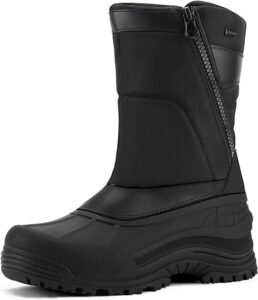
2. Insulated Waterproof Boots
These boots are designed to keep water out, providing excellent protection against splashes and immersion. Insulated waterproof boots have added warmth, making them suitable for colder conditions.
They often come with adjustable closures to create a secure seal around your ankles. Look for boots with good traction on the soles to prevent slipping on wet surfaces.
Tips on Choosing the Right Size and Fit
Selecting the correct size and ensuring a snug fit is critical for your kayaking footwear.
Try Before You Buy: Whenever possible, try on different options to find the perfect fit. Pay attention to how the footwear feels around your feet, ensuring it’s neither too tight nor too loose.
Consider Socks: If you plan to wear socks with your footwear, take this into account when selecting the size. Some people prefer thin, moisture-wicking socks for added comfort.
Ankle Support: Your footwear should provide adequate ankle support without constricting your movements. Ensure you can comfortably flex your ankles.
Toe Room: Leave a bit of room for your toes to move. Too much pressure on the toes can lead to discomfort and circulation issues.
Test with Kayak: If possible, try on the footwear while sitting in your kayak to ensure it doesn’t interfere with your paddling technique.
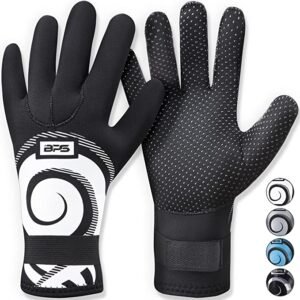
Hand Protection
While embarking on a kayaking expedition in Alaska, safeguarding your hands is paramount for several reasons.
- Cold Water Immersion: Your hands are exposed to the frigid waters of Alaska while paddling. In the event of a capsize or contact with the water, proper hand protection can prevent rapid heat loss and potential cold injuries.
- Paddle Control: Maintaining a secure grip on your paddle is essential for effective navigation. Cold, wet hands can reduce your ability to control the kayak and paddle efficiently.
- Safety and Emergency Situations: In emergencies, such as rescues or navigating obstacles, hand dexterity is vital. Adequate hand protection ensures you can respond effectively in critical situations.
When it comes to protecting your hands while kayaking in Alaska, two primary glove options are suitable:
Neoprene Gloves
Neoprene gloves provide insulation and help retain heat, which is crucial when kayaking in cold waters. They are available in various thicknesses to accommodate different temperature ranges.
These gloves offer reasonable dexterity, allowing you to maintain control over your paddle and perform tasks that require hand mobility.
Neoprene is a quick-drying material, ensuring your gloves dry relatively fast during breaks or after contact with water.
Waterproof and Insulated Mittens
Waterproof mittens, especially those insulated with materials like Thinsulate, offer superior warmth. They keep your fingers together, reducing heat loss through individual fingers.
For kayaking in extremely cold conditions, such as near glaciers, waterproof mittens provide the best protection against numbness and frostbite.
While mittens excel in warmth, they sacrifice some dexterity compared to neoprene gloves. Tasks like fine adjustments to your kayak or gear may be less precise with mittens.
Your gloves should provide a balance between dexterity and warmth. In Alaska, some kayakers combine neoprene gloves with mittens.
Neoprene gloves are worn gloves for general paddling and when the temperature drops significantly or when facing extreme cold environments they switch to waterproof mittens
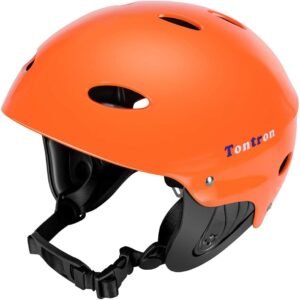
Headgear for Safety and Comfort
When kayaking in the ever-changing and often challenging weather of Alaska, appropriate headgear becomes more than just a fashion statement; it’s essential for your safety and comfort. The conditions in Alaska’s waters and climate demand headgear for several crucial reasons:
- Weather Protection: Alaska’s weather can be unpredictable, with sudden changes in temperature, wind, and precipitation. Headgear shields you from these elements, keeping you dry and warm.
- Safety: In case of capsize or unexpected immersion, headgear helps retain body heat, reducing the risk of hypothermia.
- Sun Protection: Even on cloudy days, the sun’s UV rays can be intense, especially when reflected off the water. Headgear with sun protection is vital to prevent sunburn and protect your eyes from glare.
- Comfort: Paddling for extended periods can be physically demanding. Headgear can provide comfort by keeping sweat and hair out of your face and eyes.
When choosing headgear for kayaking in Alaska, look for insulated hats made from materials like fleece or synthetic blends. These materials provide warmth even when wet and dry quickly.
Hats that cover your ears offer additional warmth and protection against wind and cold water splashes. Ensure your hat has an adjustable fit to secure it in place during windy conditions.
For whitewater kayaking, a helmet is a must. They protect your head from potential impacts with rocks, branches, or other obstacles in turbulent waters.
Your kayak helmet should fit well to prevent it from shifting during rough rides. Wearing a hat with a brim while kayaking provides protection for your eyes, face, and neck.

PFDs
PFDs are a kayaker’s most crucial piece of safety equipment. They provide buoyancy in case of capsizing and help you stay afloat, conserving energy and preventing hypothermia. Always wear a properly fitted PFD while kayaking in Alaska.
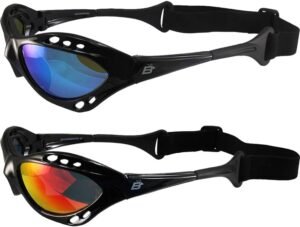
Sunglasses
There is a common misconception that due to the cold weather and snow in Alaska you need little to no limited sun protection. However, the water will reflect the sun which can affect your eyes and cause severe sunburn.
Even on cloudy days, UV radiation can be intense. Sunglasses protect your eyes from the harsh sun glare, debris, wind, and water splashes.
Polarized sunglasses reduce glare, particularly the glare caused by sunlight reflecting off water. This improves visibility and enhances your ability to spot obstacles and navigate effectively.
Accessories for Your Kayaking Comfort
In addition to your core kayaking gear, several optional accessories can significantly enhance your comfort and convenience during your Alaskan kayaking adventure.

1. Pogies (for Paddle Control)
Pogies are paddle hand covers that slip over the paddle shaft and your hands, providing additional insulation and protection against cold water splashes. They allow direct contact with the paddle, offering better control and sensitivity compared to gloves.
Pogies are excellent for kayakers who prefer a direct paddle grip. They keep your hands warm and dry while allowing you to maintain a firm hold on the paddle, essential for precise maneuvering.
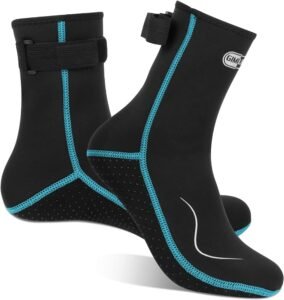
2. Neoprene Socks (Extra Insulation)
Neoprene socks offer additional insulation for your feet, keeping them warm in cold water. They are especially useful when paired with waterproof boots to provide extra warmth. Neoprene socks are versatile and can be worn in various water-related activities, including kayaking.
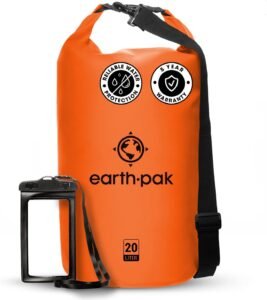
3. Dry Bags (for Storage)
Dry bags are essential for keeping your gear, clothing, and other essentials dry during your kayaking journey. They are designed to be completely waterproof and come in various sizes to accommodate different items.
Dry bags provide peace of mind, knowing your valuables won’t be ruined by water. They are indispensable for storing items like spare clothing, electronics, and food.
4. Hydration Systems (Stay Hydrated)
Staying hydrated is crucial while kayaking, even in colder climates. Hydration systems, such as hydration bladders with drinking tubes, make it convenient to sip water without stopping paddling.
Hydration systems allow you to maintain optimal hydration levels, which is essential for your overall well-being, especially during extended kayaking trips. They prevent the need to fumble with water bottles while on the water.
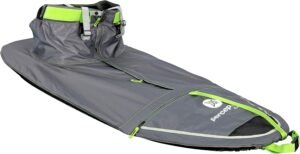
5. Spray Skirts (for Protection)
Spray skirts are essential for kayakers tackling rough waters. They create a waterproof seal between you and the kayak cockpit, preventing water from entering and keeping you dry.
Spray skirts are critical for safety and comfort when kayaking in challenging conditions. They help maintain a drier and warmer environment inside the kayak, making for a more enjoyable experience.
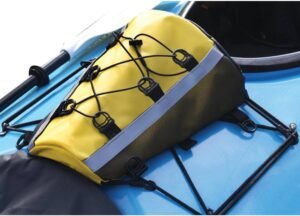
6. Deck Bags (Convenient Storage)
Deck bags are storage pouches that can be attached to the deck of your kayak. They provide convenient access to items you need frequently during your trip, such as snacks, maps, or a camera.
Deck bags keep essentials within arm’s reach, reducing the need to open hatches or dry bags while on the water. They help maintain the balance and stability of your kayak by distributing weight on the deck.
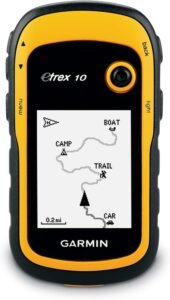
7. Navigation Tools (Stay on Course)
Navigation tools such as waterproof maps, compasses, and GPS devices are essential for safely navigating Alaskan waters. They help you stay on course and avoid getting lost.
These tools ensure you can confidently explore the intricate waterways of Alaska, making it easier to reach your desired destinations and stay safe in potentially challenging conditions.

8. First Aid Kit (Safety First)
A well-equipped first aid kit is essential for addressing minor injuries or medical emergencies while kayaking. It should include items like bandages, antiseptic wipes, pain relievers, and emergency contact information.
A first aid kit is a safety precaution that can be a literal lifesaver in case of accidents or injuries during your kayaking adventure. It’s a must-have for any outdoor excursion.
9. Rescue Equipment (Emergency gear)
Depending on the kayaking environment, carry essential rescue gear, such as throw bags, whistles, and tow lines. These tools are invaluable for assisting fellow kayakers in emergencies.
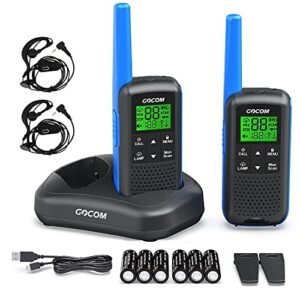
10. Communication devices
Bring a waterproof communication device, such as a VHF radio or a satellite phone, to call for help in case of emergencies or to communicate with your group.

